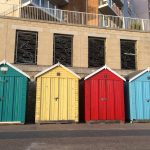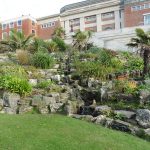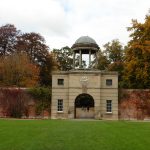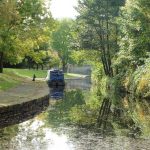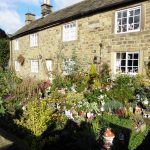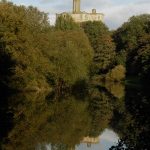Today we took a trip to Tintagel Castle, the legendary home of King Arthur. Memories of childhood stories of King Arthur and the Knights of the Round Table came rushing back as we headed there.
Tintagel Castle
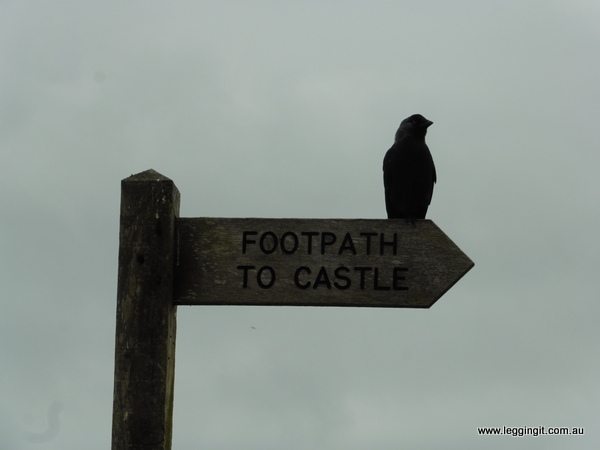
Tintagel Castle is an English Heritage property situated on the edge of the small village of Tintagel on an island of the same name. Basically it’s on a little promontory sticking out on the coast where the land joining it to the coast has broken away, so technically it’s now an island. Tintagel Castle gained fame from Geoffrey of Monmouth who wrote the History of the Kings of Britain around 1155. From his story the modern day tales of chivalry and knights have evolved. However in real life historians are unsure of where the legendary king had a castle. This is just one of the sites suggested.
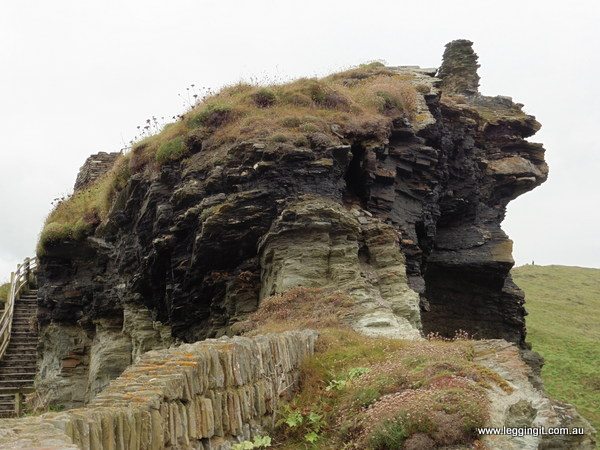
Slate found at Tintagel Castle have proved that the area was occupied during the Roman occupation. The area was probably fortified during the early medieval period by the King of Dumnonia. In 1225 the 16 year old, Richard I, the Earl of Corwall, swapped Gervase de Tintagel the land of Merthen in the west of Cornwall for Tintagel Castle. In 1233 he built an old style castle to make it look ancient. Richard I was keen to establish a connection to the legend of King Arthur. As he was not a local he was keen to also connect with the people of the area.

The castle was no Camelot as we see in the movies but a series of fortifications controlling the thin neck of land between the coast and the promontory. On the promontory a village spread out with the shear sides of the promontory protection from attack from the sea. Over the years the castle fell into disrepair as its importance waned, people moved on and successive landslides have carried away much of the central gatehouse areas transforming the promontory into an island.

What we see today is just a small part of the original castle of Tintagel. The road down to Tintagel Castle is quite steep and the English Heritage who manage the site run a shuttle service for just £2 each way. On the way down to the castle we decided to walk but it was worth considering on the walk back up the hill. We decided to take the upper fork in the road which led to the ruins of the outer fortifications. Set on top of the hill we had great views along the craggy coastline. A steep almost sheer walkway led down from the hill towards the wooden bridge connecting to the island. It’s quite amazing how many people were climbing up the rocky stairs which lead to the top of the island.

Due to the steps up to the castle being so steep Michele decided to skip the island and headed to the cafe instead. On Tintagel island there were more fortifications and ruins of buildings, including ruins of houses. One of the ruins was supposedly the garden associated with the legend of Tristan and Iseult. In the legend Tristan and Iseult met and fell in love on the boat from Ireland. When Iseult arrived at Tintagel she married the King but still was seeing Tristan on the sly. The King suspected and secretly followed them to the gardens where he was listening to them speak. They’d spied him hiding so Iseult swore aloud how she would never betray the king. Engraved pavers inside the supposed site of the gardens lay out the legend.

At the end of the island, on its most windswept spot, a statue of Arthur asks the question was Tintagel the castle of Arthurian legend. To add to the legend in the bowels of the island a cave which passes through it, is aptly named Merlins cave. There’s no cauldrons or chemistry sets in the cave just a big open space.
After visiting the island it was time to meet up with Michele at the cafe. She hadn’t been lonely for she’d met some walkers and was having a mag. All along the coast of Corwall are walking tracks so lots of people get out and enjoy the rugged coast line.
The lure of the shuttle was too much for Michele and she handed over her £2 and climbed into the passenger seat of the Landrover. I decided to save my money and walked back to the top of the hill instead.
Entry for Tintagel Castle is £7.90, for more information on opening hours look here
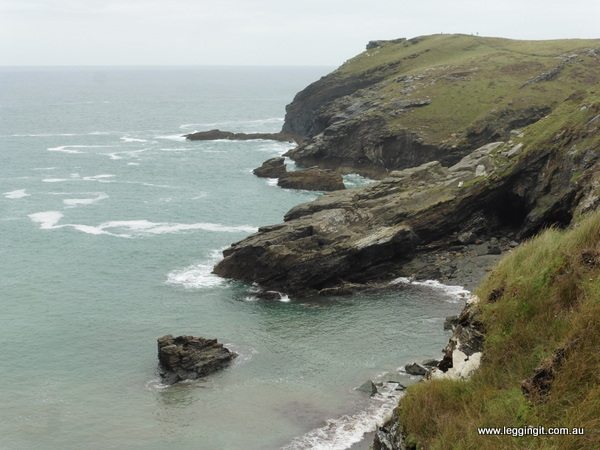
Tintagel Island has great views along the coastline and it’s quite interesting looking across to the Victorian era Camelot Castle Hotel on the nearby cliff. Inspired by the tale of King Arthur, the castle shaped hotel has great views over the ruins and was built to cash in on the legend.
Tintagel Village
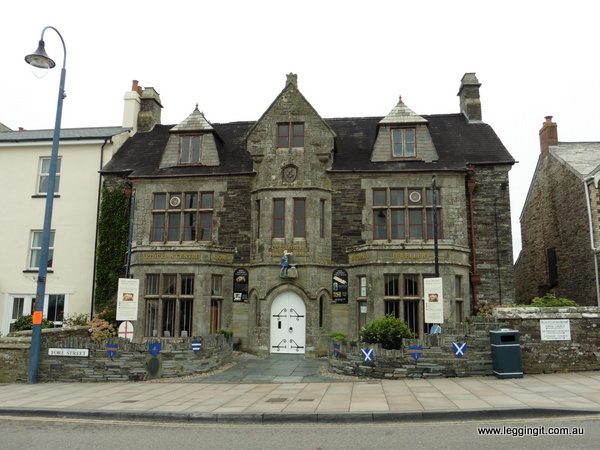
These days the village of Tintagel is built around the tourist industry with lots of businesses have names associated with the Arthurian legend. This one is a replica of King Arthur’s Great Hall. In the village there’s no street parking so the big carpark in the centre of the village is a real money spinner for the King Arthur’s Arms Inn. It probably raises more money than they make over the bar. we were tempted by their Cream Tea but when they delivered two ice hockey-like pucks left very disappointed.
Unfortunately we didn’t see the other car-park behind the Tourist Information Centre which was free for bikes.
Tintagel Old Post Office
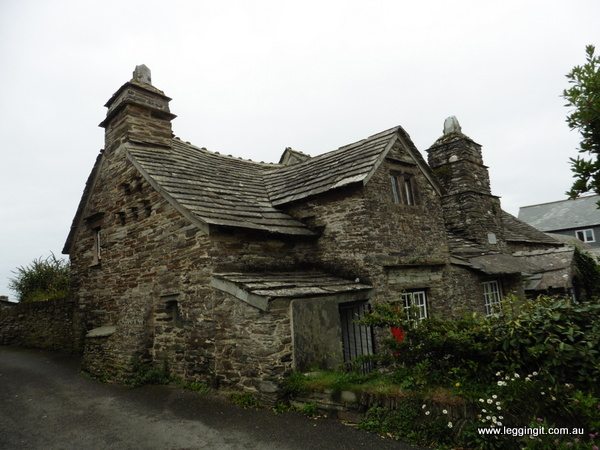
Tintagel is a lovely little village with a number of lovely old buildings including the Old Post Office. The Old Post Office dates from the 14th century and is currently managed by the National Trust. Built from stone with a local slate roof the house was originally built as a longhouse with a thatched roof. It was originally split into three rooms consisting of a bedroom, a hearth and stables.
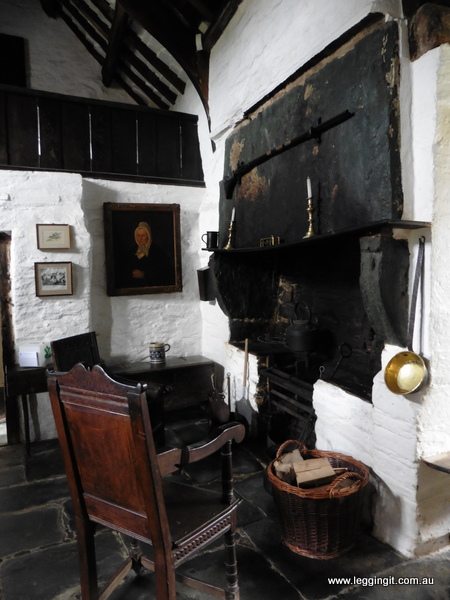
During the buildings history the thatched roof was replaced with slate, the stable removed, a parlor, upper bedrooms and gables added. At one end steps built into the wall lead to a sleeping platform. Back in “Ye Olde Days” unmarried women slept on sleeping platforms away from men. It’s where the expression being “left on the shelf” comes from.
In the middle of the building is a fascinating cloam bread oven. Built of clay the oven had no chimney and was originally fueled by gorse collected along the cliffs. At the far end is the post room with a display of Victorian era postal equipment. The old post office was briefly used in the Victorian era as a post receiving station.
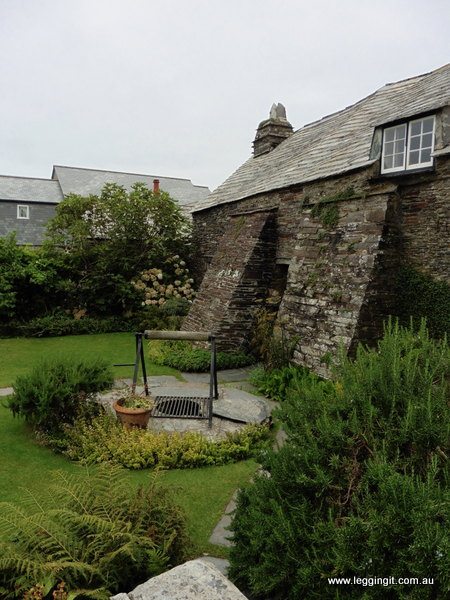
At the rear of the building a lovely garden is surrounded by a slate wall. It’s an interesting building with lots of snippets of history such as needle work and furniture dating back hundreds of years. With its slumped slate roof it really is a quaint building.
Entry for Tintagel Old Post Office, is £4 (free with National Trust Membership) For more information on opening hours look here
After visiting Tintagel Castle and the Post Office we were pretty hungry, but finding a place to eat in Tintagel is pretty easy. Cafe’s, restaurants, inns and bakeries line the streets. We settled on Cornish pasties from the local bakery but there was no shortage of different eateries with tables in sunny locations. We fell for the hype of the ‘Best Pasty’ and again were left disappointed, a mass of lots of onions and meat and no flavour just did not hit the spot.
With the clouds closing in we decided it was time to head back to Bugle, so got on the bike. For some reason the satnav took us through all the “C” roads. We call them “C” because they were a long long way from “B”roads. One lane roads with high banks on either side and grass growing up the centre. It was pretty hair raising. Tomorrow we’ve booked the bike in to get the front wheel bearing replaced and hopefully have time to visit Lanhydrock Estate.

